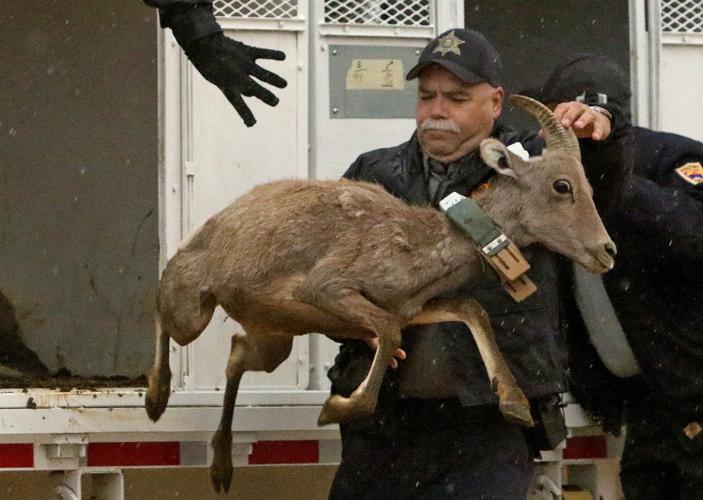Efforts to rebuild a herd of bighorn sheep in the Catalina Mountains got a boost on Monday with the release of 29 additional bighorns in the range north of Tucson.
The 23 ewes and six rams, captured in mountains near Yuma, were brought to the Catalinas by truck and released into the Pusch Ridge Wilderness area.
That’s the area where 34 bighorns are known to survive from previous relocations to the range in 2013 and 2014.
Some two dozen of the previously relocated sheep have died — some from predation by mountain lions and some from pneumonia.
“We had a very successful capture operation, so much so that we moved the release up by one day,” said Mark Hart, spokesman for the Arizona Game and Fish Department. The department, working in cooperation with a citizens advisory committee, is overseeing the effort to rebuild a herd that disappeared from the range in the 1990s.
“They were definitely headed in the right direction,” Hart said after watching the bighorns bound off for the Pusch Ridge area, where most of the surviving bighorns have settled.
More ewes than rams are brought in during the relocations because, according to Hart, “The more ewes you have, the more lambs you’ll get. And the rams will breed with multiple ewes.”
Brian Dolan, a member of the Arizona Desert Bighorn Sheep Society who serves on the citizens advisory committee, had two words to sum up the day’s events: “Excellent! Fulfillment.”
“Some call this inclement weather,” Dolan said as rain fell during the bighorn release. “But actually it’s good weather for wildlife.”
WOBBLY RAM
Hart said 30 sheep were captured in the Yuma area, but one ram was not released on Monday because it appeared wobbly when it got to its feet.
“We’re transferring the ram to our Adobe Mountain Wildlife Rehabilitation Center in Phoenix,” Hart said. “It doesn’t appear to be a broken bone or anything that’s incapacitating. So we’re not looking at euthanizing it. It could be a good animal to place in a zoo.”
Hart also noted that the number of known surviving bighorns from previous releases was lowered from 35 to 34 after a hiker found the remains of a ram during the past week.
The ram’s GPS collar had “defaulted” in a way that failed to notify wildlife officers of the animal’s demise, he said.
PNEUMONIA CONCERNS
At least four and possibly five bighorns previously brought to the Catalinas have died of pneumonia this year, and wildlife officials have made efforts to minimize the risk of new cases.
“These animals (released Monday) have resistance to pneumonia based on prior exposure” in the mountains near Yuma, Hart said.
That’s it for now
“The initial plan called for three releases” — in 2013, 2014 and 2015, Hart said.
“Nothing is planned for next year at this point.”
But he added that “supplemental releases” could be carried out depending on the health of the herd.







